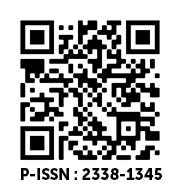Prevelence and economic inference of small ruminant foetal wastage at the Kumasi Abattoir Ltd (Kaase)
DOI:
https://doi.org/10.36782/apjsafe.v10i1.105Keywords:
economy, pregnancy losses, small ruminants, abattoirAbstract
Postmortem survey of small ruminant pregnancy wastage was conducted at Kumasi Abattoir Ltd, Kaase. Abattoir visits and investigations were conducted on 16 randomly selected abattoir working days. All mature ewes and does slaughtered on selected abattoir working days (mean = 71.69 animals/day) were included in the study, giving a total of 1,147 animals (301 ewes and 846 does). The reproductive tracts of study animals were collected at slaughter line and the uterus were grossly inspected for pregnancy. Thereafter, uterine body and horns were longitudinally incised to check the lumen for a visible fetus. The type of pregnancy (single or twin) was recorded and crown-rump length (CRL) of the largest fetus was demarcated on a piece of string and measured on a standard measuring tape. The length of gestation was estimated using the formula; Developmental Age (Days) = 2.1(Y+17), where Y = the CRL in “cm”. A survey was conducted within the premises of the Kumasi abattoir to estimate the average prices of matured small ruminants to calculate the prevailing market value of small ruminants. The potential economic impact of small ruminant abattoir fetal wastage was estimated by calculating the gross economic value and net economic value forgone due to loss of potential offspring. Kumasi Abattoir Annual Off-take was estimated to be 26,095 small ruminants where 73.8% were does and 26.2% were ewes. Pregnant does slaughtered had 37.2% of them carrying single foetus and 12.5% carrying twin foetus whereas pregnant ewes slaughtered had 28.9% carrying single foetus and 9.3% carried twin foetus. Total pregnancy wastage recorded had 3.7% early pregnancy and 96.3% mid-pregnancy with no late pregnancy recorded. Economic losses due to pregnancy wastage was estimated to be from GHS 2,755,140.80 to 3,534,791.80. The greater amounts of foetal waste encountered, places a substantial risk not only to the livestock production sector, but also to the economy of the nation.
Downloads
References
Adama, J.Y., Shiawoya, E.L., & Michael, N. 2011. Incidence of fetal wastages of cows slaughtered in Minna abattoir, Niger state, Nigeria. J. Appl. Biosci., 42: 2876-2881
Addass, P.A., Midau, A., Milka, M., & Tizhe, M.A. 2010. Assessment of abattoir foetal wastage of cattle, sheep and goat in Mubi main abattoir, Adamawa State, Nigeria. World J Agricul Sci, 6(2): 132-137.
Ahemen, T., & Zahraddeen, D. 2010. ‘Species contribution as source of meat and their foetal wastage in Taraba State, Nigeria’, Archive of Applied Science Research 2: 85-91.
Bisimwa, N.P., Lugano, R.M., Bwihangane, B.A., Wasso, S.D., Kinimi, E., Banswe, G., & Bajope, B. 2018. Prevalence of gastrointestinal helminths in slaughtered cat¬tle in Walungu territory, South Kivu province, Eastern dem¬ocratic republic of congo. Austin J. Vet. Sci. Anim. Husb., 5(1): 6.
Bokko, P.B.(2011. Pregnancy wastage in sheep and goat in the Sahel region of Nigeria. Nigerian Veterinary Journal, 32: 120-126.
Borji, H., Azizzadeha, M., & Kamelli, M. 2011. A retrospective study of abattoir condemnation due to parasitic infections: economic importance in Ahwaz, southwestern Iran. Iranian Journal of Parasitology 98(5): 954-957
Chaudhari, S.U.R., & Paul-Bokko, B. 2000. Reproductive status, pregnancy wastage and incidence of gross genital abnormalities in cows slaughtered at Maiduguri abattoir, Nigeria. Pakistan Vet. J. 20(4), 203-205
FAO (Food and Agriculture Organization of the United Nations). 2006. State of World Food Insecurity, FAO, Rome, Italy. p67.
Fayemi, P. O., & Muchenjie, V. 2013. Maternal slaughter at abattoirs: history, causes, cases and the meat industry, Springer Plus, 2:125.
Goossens, B., Osaer, S., Kora, S., Chandler, K. J., Petrie, L., Thevassagayam, J. A., Woolhouse, T., & Anderson, J. 1998. Abattoir survey of sheep and goats in The Gambia. The Veterinary Record 142(11): 277-81
Grandin, T. 2004. Restaurant Animal Welfare Audits of Stunning and Handling in federally inspected U.S. and Canadian beef, veal, pork, lamb, and poultry slaughter plants. Available on: http//www.grandin.com/survey.
Kassahun, A., & Solomon, A. 2008. Breeds of sheep and goats. In: Sheep and Goat Production Handbook for Ethiopia. Ed Alemu Yami and R.C. Merkel. Addis Ababa, Ethiopia.
Kheradmand, A., Batavani, R. A., & Babaei, H. 2006. Study on the frequency of pregnant ewes slaughtered in Khorram Abad abattoir, Iran, Iranian Journal of Veterinary Research, 7(1), Ser. No. 14.
Lawton, D. E. B., Mead, F. M., & Baldwin, R. R. 2000. Farmer record of pregnancy status pre-slaughter compared with actual pregnancy status post-slaughter and prevalence of gross genital tract abnormalities in New Zealand dairy cows. New Zealand Veterinary Journal 48: 160-165.
Mshelia, G.D., Maina, V.A., & Aminu, M.D. 2015. Foetometrics and economic impact analysis of reproductive wastages in ruminant species slaughtered in North-Eastern Nigeria. J. Anim. Prod. Adv., 5(4): 645-653.
Muhammad, B. F. Haruna, I. Y., Abdulsamad, A. M., & Bichi, J. M. 2009. Foetal wastage in Northern Nigerian: The case of Gombe abattoir, Gombe State. Proceedings of the 13th Annual Conference of Animal Science (ACAS ’08). ABU, Zaria 13:124–127
Mutwedu, V.B., Buuma, B.K., Mushagalusa, A.C., Bisimwa, N.P., Cirezi, N.C., Mugumaarhahama, Y., & Ayagirwe, R.B.B. 2019. Prevalence and economic losses of calf fetal wastage in ELAKAT public slaughterhouse of Bukavu, Democratic Republic of Congo, Veterinary World, 12(10): 1644-1649
Ngbede, E. O., Raji, M. A., Kwanashie, C. A., Okolocha, E. C., Gugong, V. T., & Hambolu, S. E. 2012. Serological prevalence of Leptospirosis in cattle slaughtered in the Zango abattoir in Zaria, Kaduna State, Nigeria. Veterinaria Italiana, 48(2): 179-184.
Noakes, D. E., Parkinson, T. J., & England, G. C. W. 2001. Arthur’s Veterinary Reproduction and Obstetrics. 8th Edn. London, W. B. Saunders Co., Pp: 28, 557-570.
Okorie-Kanu, O.J., Ezenduka, E.V., Okorie-kanu, C.O., Anyaoha, C.O., Attah, C.A., Ejiofor, T.E., & Onwumere- Idolor, S.O. 2018. Slaughter of pregnant goats for meat at Nsukka slaughterhouse and its economic implications: A public health concern. Vet. World, 11(8): 1139-1144.
Paul, O., Amuta, K.A., Tordue, C.A.K., & Linus I.M. 2018. Economic Implication of Foetal Wastages through Slaughter of Pregnant Pigs: A Case Study of the Makurdi Municipal Abattoir in Benue State, Nigeria. Asian Journal of Research in Animal and Veterinary Sciences 1(2): 1-8.
Sanusi, M., Abubakar, M., & Luka, B. 2006. Incidence of Foetal Wastages in Ruminant Animals Slaughtered at Bauchi and Jos Abattoirs. In; the Proceedings of the 2006 Annual Nigerian Society for Animal Production Conference, 102-106.
Simenew, K., Bekana, M., Fikre, L., Tilahun, Z., & Wondu, M. 2011. Major Gross Reproductive Tract Abnormalities in Female Cattle Slaughtered at Sululta Slaughterhouse in Ethiopia. Global Veterinaria 6(6): 506-513.
Singleton, G. H., & Dobson, H. 1995. A survey of the reasons for culling pregnant cows. Veterinary Records, 136: 162-165.
Swai, E. S. Ayubu, H., & Mhina, B. S. 2015. Incidence of foetal wastage in sheep and goats slaughtered at Tanga city abattoir, Tanga, Tanzania. Livestock Research for Rural Development. Volume 27, Article #213. Retrieved February 27, 2020, from http://www.lrrd.org/lrrd27/10/swai27213.html
Tamirat, C., Wakayo, B. U., Mohammed, O., & Dewo T.F. 2015. Small ruminant fetal wastage at Asella abattoir in central Ethiopia; reflection on potential country level implications. International Journal of Livestock Research 5(11): 55-61
Tizhe, M.A, Kubkomawa, H. I., Waba, Y.E., & Addass, P.A. 2010. Foetal wastage in ruminants and sustainable livestock industry in Nigeria, Journal of Agriculture and Veterinary Sciences Volume 2, Pp 72 – 80.
Wilson, R.T. 1982. Husbandry, nutrition and productivity of goats and sheep in tropical Africa. In: Gatenby R.M. and T rail J.C.M. (eds). Small ruminant breed productivity in Africa. Proceedings of a seminar held at ILCA, Addis Ababa, Ethiopia.
Zakia, L.G., & David, W. P. 2016. Brucellosis Vaccine for Livestock. Veterinary Immunology and Immunopathology. Elsevier hlt://dx.doi.org/10.1016.j.vetmm.2016.03.011.






